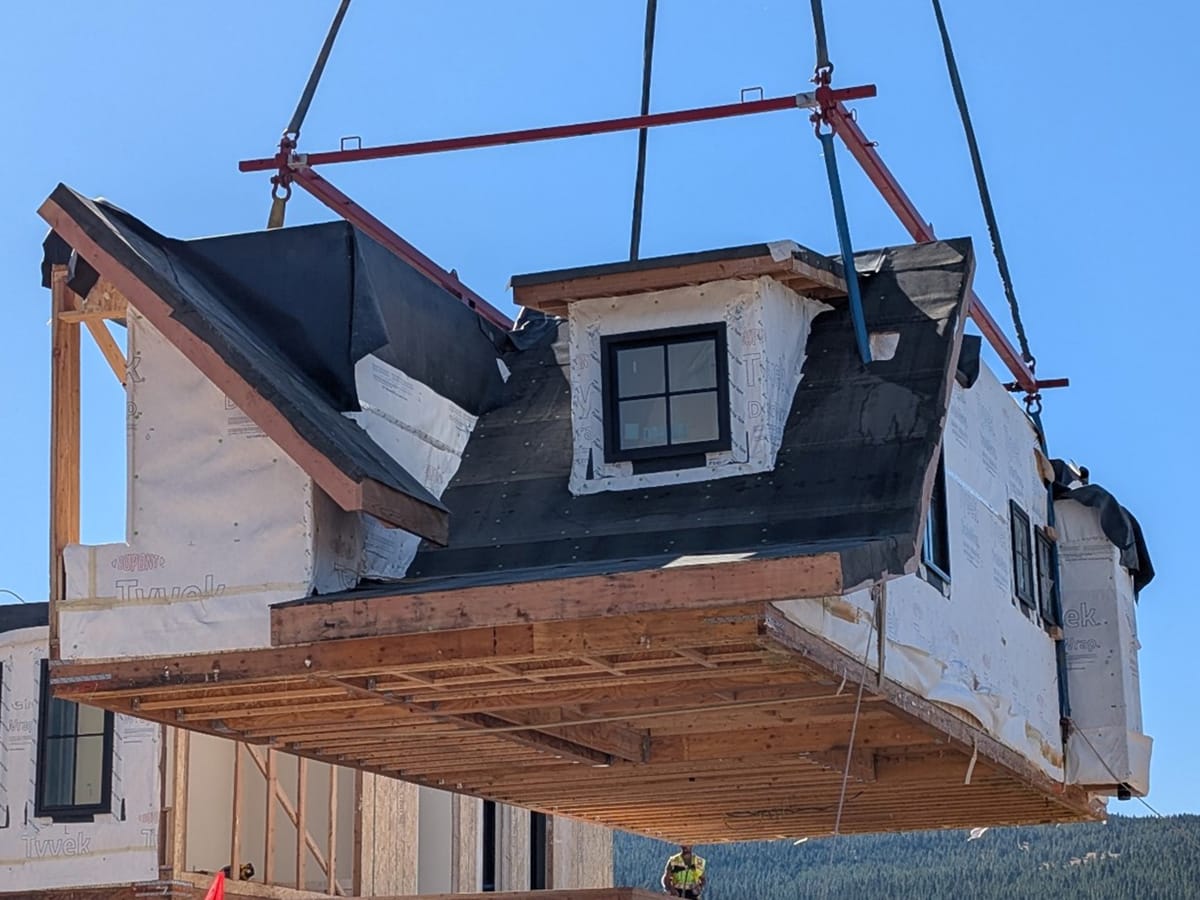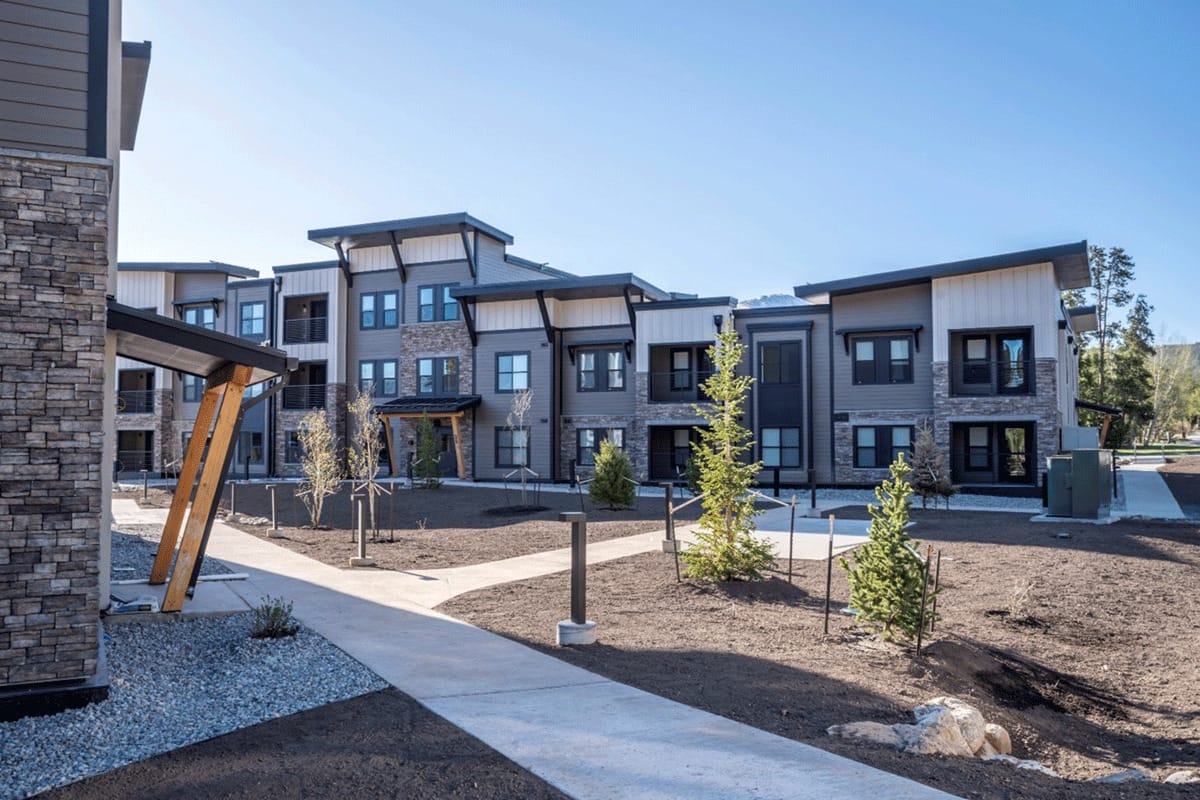Opportunities for Innovation in Modular Offsite Construction

Alex Walz is a project architect at EVstudio.
The construction industry is undergoing a seismic shift as Fully Volumetric Modular Offsite Construction takes center stage. This innovative approach addresses challenges like affordability, efficiency, and sustainability while opening doors to groundbreaking advancements. To realize its full potential, an experienced, interdisciplinary team is crucial for successfully delivering state of the art Modular projects. Tremendous opportunities exist for innovation across architecture, structural engineering, and mechanical and electrical systems. Pioneering A/E firms are leading the way.
Architectural Innovations: Beautiful Buildings Without Compromise
Modular Offsite Construction has already shattered the myth that it only produces uninspired, box-like designs. Architectural innovations in module geometry, configurations, materials, and products make it possible to create visually stunning buildings without sacrificing functionality or efficiency.
Experienced architects utilize cutting-edge tools like Building Information Modeling (BIM) and design tools augmented with Artificial Intelligence (AI) to design unique modular geometries. Today’s modules can feature angled walls, curved surfaces, and staggered configurations that achieve dynamic forms and creative façades. For example, staggered modules can produce cantilevered elements and shifts in the building facade, while innovative layouts create seamless architectural flow. Collaboration among seasoned professionals in modular design ensures these designs align with manufacturing and assembly capabilities.

Figure 1a: Unique module form in fabrication stage with sloping roofs and dormer construction.

Figure 1b: Unique module forms flown during setting.
Innovative Materials and Products
Material advancements are redefining what’s possible in Modular Offsite Construction. Lightweight yet durable options like cross-laminated timber (CLT) and high-performance lightweight concrete enhance design flexibility. Ultra-slim insulation panels and panelized façade systems maximize interior space without compromising thermal performance. Sheathing products with integrated insulation and waterproofing reduce construction time and speed factory production. These innovations enable architects to create striking, sustainable structures that rival traditionally built projects.
Blending Aesthetics and Functionality
Customizable designs allow modular buildings to integrate seamlessly into their surroundings and even stand out as architectural landmarks. Architects working with modular experienced engineers ensure that every detail enhances both form and function. By combining design expertise with state-of-the-art tools, experienced modular designers deliver projects that meet the highest aesthetic and functional standards.

Figure 2: The Larkspur in Breckenridge Colorado - a stunning Modular apartment building indistinguishable from stick frame.
Structural Engineering Advancements: Simplifying Processes and Enhancing Durability
Structural engineering innovations are essential to the success of Modular Offsite Construction. With modular experienced engineers leading the way, these advancements simplify factory and field work while ensuring robust and resilient buildings.
Streamlining Factory and Field Work
Structural Engineers design modular frames using high-strength materials, such as steel and engineered lumber, to optimize manufacturing and assembly. Pre-installed components, like shear walls and bolted plate connectors, reduce the need for complex on-site work. These solutions accelerate timelines while improving precision and quality control.
Designing for Strength and Resilience
Transporting and assembling modules requires designs that prioritize durability. Structural Engineers develop advanced connection systems that ensure integrity during transport and installation. By incorporating seismic and wind-resistant features, they make modular buildings suitable for diverse climates and geographic locations. Experienced teams bring a deep understanding of these challenges, ensuring every project meets rigorous safety standards.
Advanced Technologies in Mechanical and Electrical Systems
Mechanical and Electrical Engineering innovations are transforming modular construction by delivering purpose-built systems that enhance energy efficiency, occupant comfort, and sustainability. With seasoned professionals driving these advancements, modular buildings are achieving industry leading performance standards.
Purpose-Built MEP Systems
MEP systems designed specifically for modular buildings simplify installation and improve reliability. Compact HVAC units fit within tighter spaces, while pre-wired electrical systems and plumbing assemblies intentionally designed for modular minimize on-site labor. These systems are tested in the factory, ensuring they perform as intended once installed.
Optimizing Energy Performance
Advanced technologies like smart HVAC systems and LED lighting with integrated controls optimize energy use. Renewable energy solutions, such as pre-installed solar panels and battery storage, further enhance building sustainability. These systems provide a level of performance and efficiency tailored to modular construction’s unique needs.

Figure 4a: Integrated BIM model with Structural framing coordinated with MEP systems shown
Integrated Collaboration Across Disciplines
Mechanical and Electrical Engineering innovations are transforming modular construction by delivering purpose-built systems that enhance energy efficiency, occupant comfort, and sustainability. With seasoned professionals driving these advancements, modular buildings are achieving industry leading performance standards.
EVstudio’s Role in Modular Innovation
EVstudio is an integrated Architecture and Engineering firm with multiple offices and staff across the country. Leveraging decades of expertise in architecture and engineering, EVstudio pushes the boundaries of what is possible in all market sectors. Within EVstudio, a purpose built team of specialists in Design for Offsite Construction known as the EVolution Studio focuses exclusively on advancing building technologies for Offsite Construction. EVstudio supports Manufacturers, Owners and General Contractors alike and ensures all stakeholder needs are met.
Integrated Design Approach
EVstudio employs an integrated design approach that brings together in-house Architects, Structural Engineers, and MEP Engineers all within the same Studio from project inception. This collaboration ensures that every aspect of the design is optimized for modular construction. By using advanced tools like BIM and parametric modeling with AI augmented capability coupled with good old fashioned human know-how and experience, EVstudio delivers designs that balance aesthetics, functionality, and efficiency.
Collaborating with NREL for High-Performance Systems
The National Renewable Energy Laboratory (NREL), based in Golden Colorado, focuses research on integrating renewable energy technologies into modular construction. The lab’s work includes energy-efficient heat pumps and other advanced systems as well as materials for improved insulation and air-sealing. Through its collaboration with NREL, EVstudio is at the forefront of implementing these innovations in real-world projects, setting new standards for sustainability in Modular Offsite Construction.
Pioneering Reversible Design™
EVstudio has introduced Reversible Design™, a groundbreaking proprietary system of A/E building technologies that enables buildings to be deconstructed and relocated without compromising aesthetics or function. Reversible Buildings™ use modular components designed for easy disassembly, promoting adaptability and reducing waste while also providing substantial financial and risk mitigation benefits to Owners and Developers. This innovative approach exemplifies EVstudio’s commitment to transforming the construction industry.
Conclusion
Modular Offsite Construction offers tremendous opportunities for innovation across Architecture, Structural Engineering, and MEP Engineering. With modular experienced teams leading the way, modular buildings can achieve stunning aesthetics, exceptional performance, and unparalleled sustainability. EVstudio, through its integrated design approach and collaboration with NREL, exemplifies how expertise and innovation drive the modular industry forward. By introducing Reversible Design™, EVstudio is not only redefining modular construction but also challenging traditional notions of what buildings can be. Modular offsite construction is poised to revolutionize the industry, creating a future of efficient, sustainable, and adaptable buildings.
Contact us to explore how to add significant value to your next project using Modular Offsite Construction and take advantage of all the innovations available. We can be reached by email at design@evstudio.com, by phone at 866-323-5882, or through our website.
More from Modular Advantage
Resia: Breaking All the Rules
Resia Manufacturing, a division of U.S.-based Resia, is now offering prefabricated bathroom and kitchen components to industry partners. Its hybrid fabrication facility produces more precise bathroom and kitchen components (modules) faster and at lower cost than traditional construction. Here’s how Resia Manufacturing does it.
How LINQ Modular Innovates to Bring Modular To The Market in the UAE and Beyond
LINQ Modular, with an office and three manufacturing facilities in Dubai, is a modular firm based in United Arab Emirates. The company is on a mission: to break open the housing and construction markets in the Gulf Cooperation Council (GCC) area with modular.
ModMax: Redefining Modular Construction with Confidence and Precision
ModMax was born out of frustration—frustration with five persistent pain points in modular construction: Permitting bottlenecks. Production delays. Rigid designs. Disconnect between “the office” and the field. Lack of transparency and communication.
LifeArk: Disaster-Resilient Housing from Recycled Plastic and 100-year-old Technology
Wee compares LifeArk’s housing units to Yeti coolers, as they are built similarly. Each component takes 15 to 20 minutes to manufacture, has an R-value of 40, and includes molded slots and chases for wiring, plumbing, fire sprinklers, and other utilities.
Building the Future of Modular Edge Infrastructure
The edge data center market is expanding rapidly, driven by the surge in AI workloads, IoT adoption, and the need for localized compute power. In these environments, sustainability, scalability, and reliability are non-negotiable. Cooling is among the most complex challenges for operators—and one of the most decisive factors in long-term success.
Accelerating Light-Gauge Steel Construction: A Semi-Automated Digital Workflow for Off-Site Projects
For construction professionals, the message is clear. By adopting semi-automation and digitalization, companies can deliver projects faster, more accurately, and more profitably, while also building stronger collaboration across teams. The approach is not about replacing people with machines, but about empowering people with better tools and processes.
Why Modular Data Centers Are Gaining Momentum
Artificial intelligence, high-performance computing, and edge applications push the limits of traditional “stick-built” data centers. They take years build, often struggle with high density workloads, and aren’t optimized for deployments near end users. Modular data center platforms are purpose-built to address these challenges, offering flexibility and scalability to adapt to evolving technologies, while opening new opportunities for the modular construction industry.
Supply Chain Innovation in Action: 5 Habits Every Modular Leader Should Practice
By applying these principles to supply chain practices — collaborative planning, strategic procurement, scenario modeling, digital tools, and transparent forecasting — construction leaders can build value chains that are not just efficient and agile, but truly innovative.
Exploring the Role of Modular Integrated Construction (MiC) in Advancing Circular City Principles – A Survey of Stakeholder Perspectives
The survey findings highlight the significant potential of Modular integrated Construction (MiC) in advancing the development of circular cities. By reducing costs, accelerating construction timelines, and minimizing waste generation, MiC offers a promising approach to sustainable urban development.
The Use of MS POLYMER™-Based Sealants and Adhesives in Modular Building
These products combine flexibility and elastic recovery with excellent adhesion to different substrates and have already shown their usefulness in traditional construction. Now it’s time for them to be put to use in the modular construction industry.










